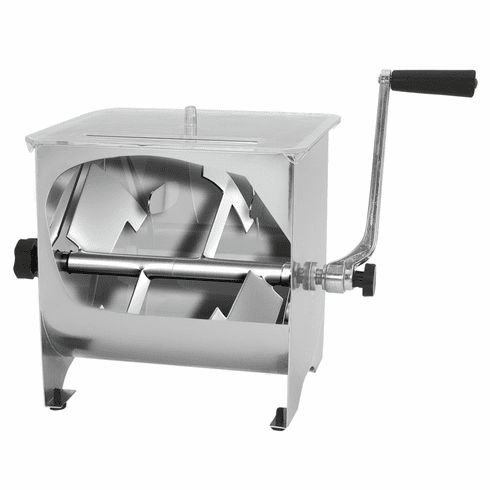Has anyone had experience or any thoughts on using a ribbon mixer (for mixing sausage) as a dough mixer? I have been pouring over Amazon listings and a manual ribbon mixer seems like it would do a great job of mixing dough.
I'd love to hear your thoughts.
~Strong Wife

That device would cut the dough too much.
If you want to mix a large batch of dough by hand, a large bowl or square tub and a large spoon or paddle, gets you started, then hand folding to finish up the initial mix.
A small to medium batch, in a smaller bowl, with the handle end of a wooden spoon.
If you want a device for _kneading_ dough, you definitely need something that is not going to "cut".
But the initial mix for dough, large or small batches, really isn't that hard, especially for high hydration artisan bread dough.
The problem is that we use the term "mixer" for devices that first, literally mix the ingrediencts, and second, _knead_ the dough. Usually, as in a Kitchen Aid brand mixer, that involves changing the "mixing paddle" for the "dough hook" which does the kneading.
contributor mariana who uses a food processor.
http://www.thefreshloaf.com/node/54803/chasing-thin-crispy-not-thicktough-dough#comment-396185
I think this could work just fine for dough. Charles van Over published an entire book on mixing bread in a food processor, and Modernist Bread describes the food processor as an “extremely fast way to produce bread; great for beginners,” “easy method for less experienced bakers,” “fast way to mix doughs that require long mixing time...highly recommended for sandwich bread and challah”, and describing loaf volume for the van Over method as equivalent to hand mixing. The caveat in all of these is a resultant tight crumb structure. But it works just fine to mix dough.
Al and Michael, I thought of the many references that baking literature has to using food processors for the initial mix.
But this device has _static blades_ in addition to the rotating blades, so it's not the same.
There are also more moving blade surfaces and edges to clean, therefore efficiency seems poor for just one batch: it will take longer to take apart, clean, and reassemble this device than it would to mix by hand and then clean the bowl, wooden spoon/paddle and hands. For just one or two normal size loaves, I don't see this as an efficient or cost effective endeavor.
Depending on the hydration level, and amount of dough, it could also turn out to be very difficult to crank by hand.
Moreover, the blades (four moving and at least two static) might end up working in a way that would cut and separate the dough instead of making it come together in one ball.
Though if multiple batches at a time are planned, and a manual device is desired over an electric one, and use is restricted to initial mix and not kneading, yes, it is possible it might work out, and be worthwhile. But, does the poster want to be the "pilot project" and spend money to find out?
If someone already owns one of these to make sausage, and wants to try mixing dough in it, it's worth a shot. Dual-use is always good.
But to go out and buy a sausage mixer _just_ for dough, in my opinion, will lead to buyer's remorse. They will likely wish they had put the money towards a stand mixer that can also knead with a dough hook, an actual food processor, a grain mill, or something else more conducive/efficient for baking.
What did you go with? My fave bagel shops in Montreal use the ribbon mixer.